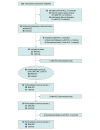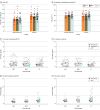Functional Limitations and Exercise Intolerance in Patients With Post-COVID Condition: A Randomized Crossover Clinical Trial
- PMID: 38573638
- PMCID: PMC11192186
- DOI: 10.1001/jamanetworkopen.2024.4386
Functional Limitations and Exercise Intolerance in Patients With Post-COVID Condition: A Randomized Crossover Clinical Trial
Abstract
Importance: Many patients with post-COVID condition (PCC) experience persistent fatigue, muscle pain, and cognitive problems that worsen after exertion (referred to as postexertional malaise). Recommendations currently advise against exercise in this population to prevent symptom worsening; however, prolonged inactivity is associated with risk of long-term health deterioration.
Objective: To assess postexertional symptoms in patients with PCC after exercise compared with control participants and to comprehensively investigate the physiologic mechanisms underlying PCC.
Design, setting, and participants: In this randomized crossover clinical trial, nonhospitalized patients without concomitant diseases and with persistent (≥3 months) symptoms, including postexertional malaise, after SARS-CoV-2 infection were recruited in Sweden from September 2022 to July 2023. Age- and sex-matched control participants were also recruited.
Interventions: After comprehensive physiologic characterization, participants completed 3 exercise trials (high-intensity interval training [HIIT], moderate-intensity continuous training [MICT], and strength training [ST]) in a randomized order. Symptoms were reported at baseline, immediately after exercise, and 48 hours after exercise.
Main outcomes and measures: The primary outcome was between-group differences in changes in fatigue symptoms from baseline to 48 hours after exercise, assessed via the visual analog scale (VAS). Questionnaires, cardiopulmonary exercise testing, inflammatory markers, and physiologic characterization provided information on the physiologic function of patients with PCC.
Results: Thirty-one patients with PCC (mean [SD] age, 46.6 [10.0] years; 24 [77%] women) and 31 healthy control participants (mean [SD] age, 47.3 [8.9] years; 23 [74%] women) were included. Patients with PCC reported more symptoms than controls at all time points. However, there was no difference between the groups in the worsening of fatigue in response to the different exercises (mean [SD] VAS ranks for HIIT: PCC, 29.3 [19.5]; controls, 28.7 [11.4]; P = .08; MICT: PCC, 31.2 [17.0]; controls, 24.6 [11.7]; P = .09; ST: PCC, 31.0 [19.7]; controls, 28.1 [12.2]; P = .49). Patients with PCC had greater exacerbation of muscle pain after HIIT (mean [SD] VAS ranks, 33.4 [17.7] vs 25.0 [11.3]; P = .04) and reported more concentration difficulties after MICT (mean [SD] VAS ranks, 33.0 [17.1] vs 23.3 [10.6]; P = .03) compared with controls. At baseline, patients with PCC showed preserved lung and heart function but had a 21% lower peak volume of oxygen consumption (mean difference: -6.8 mL/kg/min; 95% CI, -10.7 to -2.9 mL/kg/min; P < .001) and less isometric knee extension muscle strength (mean difference: -37 Nm; 95% CI, -67 to -7 Nm; P = .02) compared with controls. Patients with PCC spent 43% less time on moderate to vigorous physical activity (mean difference, -26.5 minutes/d; 95% CI, -42.0 to -11.1 minutes/d; P = .001). Of note, 4 patients with PCC (13%) had postural orthostatic tachycardia, and 18 of 29 (62%) showed signs of myopathy as determined by neurophysiologic testing.
Conclusions and relevance: In this study, nonhospitalized patients with PCC generally tolerated exercise with preserved cardiovascular function but showed lower aerobic capacity and less muscle strength than the control group. They also showed signs of postural orthostatic tachycardia and myopathy. The findings suggest cautious exercise adoption could be recommended to prevent further skeletal muscle deconditioning and health impairment in patients with PCC.
Trial registration: ClinicalTrials.gov Identifier: NCT05445830.
Conflict of interest statement
Figures



Comment in
-
Exercise Therapy for Post-COVID-19 Condition-Does No Harm.JAMA Netw Open. 2024 Apr 1;7(4):e246959. doi: 10.1001/jamanetworkopen.2024.6959. JAMA Netw Open. 2024. PMID: 38573640 No abstract available.
References
-
- World Health Organization. Coronavirus disease (COVID-19): post COVID-19 condition. Accessed November 30, 2023. https://www.who.int/news-room/questions-and-answers/item/coronavirus-dis...
-
- World Health Organization . Clinical management of COVID-19: living guideline. January 13, 2023. Accessed January 31, 2024. https://iris.who.int/bitstream/handle/10665/365580/WHO-2019-nCoV-clinica... - PubMed
-
- World Physiotherapy . World Physiotherapy response to COVID-19: safe rehabilitation approaches for people living with long COVID—physical activity and exercise. Briefing paper 9. June 2021. Accessed January 31, 2024. https://world.physio/sites/default/files/2021-06/Briefing-Paper-9-Long-C...
Publication types
MeSH terms
Associated data
LinkOut - more resources
Full Text Sources
Medical
Miscellaneous

